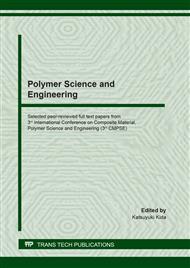[1]
W.T. Tsai, J.M. Yang, C.W. Lai, Y.H. Cheng, C.C. Lin, C.W. Yeh. Characterization and adsorption properties of eggshells and eggshell membrane. Bioresour. Technol. 97 (2006) 488-493.
DOI: 10.1016/j.biortech.2005.02.050
Google Scholar
[2]
N.Tangboriboon, W.Unjan, W.Sangwan, A.Sirivat. Preparation of anhydrite via pyrolysis. Green Processing and Synthesis. 7/2(2018) 139-146.
DOI: 10.1515/gps-2016-0159
Google Scholar
[3]
N.Tangboriboon, R.Kunanuraksapong, A. Sirivat. Preparation and properties of calcium oxide from eggshells via calcination. Materials Science-Poland. 30/4(2012) 313-322.
DOI: 10.2478/s13536-012-0055-7
Google Scholar
[4]
A.I. Badanoiu, T.H. Abood Al Saadi, S.Stoleriu, G.Voicu. Preparation and characterization of foamed geopolymers from waste glass and red mud. Construction and Building Materials. 84(2015) 284-293.
DOI: 10.1016/j.conbuildmat.2015.03.004
Google Scholar
[5]
A.Kashani, T.D. Ngo, A.Hajimohammadi. Effect of recycled glass fines on mechanical and durability properties of concrete foam in comparison with traditional cementitious fines. Cement and Concrete Composites. 99(2019) 120-129.
DOI: 10.1016/j.cemconcomp.2019.03.004
Google Scholar
[6]
M.J. Woźniak, A.Chlanda, P.Oberbek, M.Heljak, K.Czarnecka, M.Janeta, L.John. Binary bioactive glass composite scaffolds for bone tissue engineering‒Structure and mechanical properties in micro and nano scale, A preliminary study. Micron.119(2019) 64-71.
DOI: 10.1016/j.micron.2018.12.006
Google Scholar
[7]
J.R. Jones. Review of bioactive glass: from Hench to hybrids. Acta Biomater. 9 (2013) 4457-4486.
DOI: 10.1016/j.actbio.2012.08.023
Google Scholar
[8]
A.Nommeots-Nomm, S.Labbaf, A.Devlin, N.Todd, H.Geng, et al. Highly degradable porous melt-derived bioactive glass foam scaffolds for bone regeneration. Acta Biomater. 57(2017) 449-461.
DOI: 10.1016/j.actbio.2017.04.030
Google Scholar
[9]
P.F. Menci, A.Mari, C.Charbonneau, L.P. Lefebvre, L.D. Nardo. Aging of Bioactive Glass-Based Foams: Effects on Structure, Properties, and Bioactivity. Materials.12(2019) 1485-1497.
DOI: 10.3390/ma12091485
Google Scholar
[10]
Z.Zhang, Y.C. Wong, A.Arulrajah, S.Horpibulsuk. A review of studies on bricks using alternative materials and approaches. Construction and Building Materials. 188(2018) 1101-1118.
DOI: 10.1016/j.conbuildmat.2018.08.152
Google Scholar
[11]
Y.H.M. Amran, N.Farzadnia, A.A.A. Ali. Properties and applications of foamed concrete; a review. Construction and Building Materials. 101(2015) 990-1005.
DOI: 10.1016/j.conbuildmat.2015.10.112
Google Scholar
[12]
Z.Y.Wu, R.G. Hill, S.Yue, D.Nightingale, P.D. Lee, J.R. Jones. Melt-derived bioactive glass scaffolds produced by a gel-cast foaming technique. Acta Biomater. 7(2011) 1807-1816.
DOI: 10.1016/j.actbio.2010.11.041
Google Scholar
[13]
Q. Fu, E.Saiz, A.P. Tomsia. Direct ink writing of highly porous and strong glass scaffolds for load-bearing bone defects repair and regeneration. Acta Biomater. 7(2011) 3547-3554.
DOI: 10.1016/j.actbio.2011.06.030
Google Scholar
[14]
N. Tangboriboon, Kunanuraksapong, R., and Sirivat, A. Preparation and properties of calcium oxide from eggshells via calcination. Materials Science-Poland, 30/4(2012): 313-322.
DOI: 10.2478/s13536-012-0055-7
Google Scholar
[15]
Nuchnapa Tangboriboon, Sopita Moonsri, Artima Netthip, Watchara Sangwan, Anuvat Sirivat. Enhancing physical-thermal-mechanical properties of fired clay bricks by eggshell as a bio-filler and flux. Science of Sintering. 51/1(2019): 1-13.
DOI: 10.2298/sos1901001t
Google Scholar


